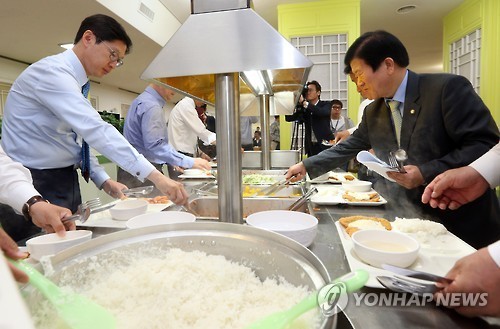More of South Korea’s state-run organizations are joining the drive to shut down their in-house cafeterias at least once a week as part of efforts to spur the local economy amid the deepening economic downturn.
Mostly municipalities, police stations and state-run organizations across the country are seen joining the campaign to boost spending at nearby restaurants once a week or twice a month.
Among them is Seoul’s Seocho District Office, which decided to close its in-house cafeteria every Friday. The office estimates that about 700 million won ($615,419) a year will be spent at nearby restaurants instead, given that it has some 1,500 employees.
The practice had initially began when the Middle East respiratory syndrome outbreak took a toll on the local economy last year. It decided to expand its “Eating-Out Day” program at the request of local restaurant owners.
 |
Lawmakers eat their lunch at the National Assembly’s cafeteria. (Yonhap) |
“We decided to enforce the rule to help revitalize the local economy. Restaurant owners are happy about it, saying they see a growing number of customers,” said Kim In-ha, a government official at Seocho District Office.
“It is true that staff members have some trouble going out, finding restaurants outside and coming back in this hot weather.”
Other municipalities including Ansan’s Danwon-gu Office, Incheon’s Dong-gu Office, Wonju City Hall, Tongyeong City Hall, Busan City Hall and South Gyeongsang Provincial Office also joined the drive to encourage their employees to venture out and spend money during lunch.
Small restaurant owners welcomed the idea, but also called for wider implementation of the campaign.
“We cannot dramatically benefit from the shutdown of in-house cafeterias at Cheongju City Hall as it is a relatively small-sized office, but we can receive more customers at least once a week,” said Son Yeon-ju, a director of an association of Cheongju-based restaurant owners. Cheongju City Hall also closes its cafeteria every Wednesday.
“In order to really help the local economy, all the state-funded companies as well as district offices should join the campaign. Otherwise, it would only have limited impact.”
A local restaurant owner in southern Seoul, who wanted to be identified only by his surname Kim, echoed hope that the public firms’ adoption of “Eating-Out Day” will encourage private companies to do the same.
“When Seocho District Office’s cafeteria closes, not only public servants but also citizens who visit the office go to nearby restaurants for meals,” said one of the local restaurant owners in southern Seoul. “As the local economy is slowing, many restaurants in the area benefit from such measures.”
“It would be even better if big private companies join the move.”
The move, however, is also opposed by some Korean workers, who cite their right to cut down on food costs, maximize productivity and choose healthier options.
“It is good to use the in-house cafeteria because I can save money and I don’t have to think about what to eat every day. I save about 3,000 won per meal now compared to in the past when our company did not have a cafeteria,” said Song Ji-hee, a 27-year-old office worker in Seoul.
“Also, food from the cafeteria is a lot healthier with lower levels of salt and calories,” said Song, who usually eats at her workplace restaurant and eats out about twice a week.
“Offering the in-house dining options is a crucial part to improving the health and welfare of employees.”
According to a survey of 1,115 office workers by the job portal site Job Korea, South Koreans on average spend 6,370 won on lunch in 2016, down from 6,566 won. However, 46.3 percent of the respondents said they think they pay more for lunch this year.
The poll found that Korean workers spend on average 7,816 won on a meal when they eat out at a nearby restaurant and 5,431 won when they dine at their companies’ cafeterias. They pay on average 4,882 won for a meal from a convenience store.
“I would be happy to have a cafeteria at my workplace. That way, I can save time and a lot of money,” said Seo In-ki, 29, who often goes to convenience stores for a simple and quick meal.
“I would still go out and have lunch outside when I want to, but I wish I could have a cheaper, quicker dining option at my workplace.”
By Ock Hyun-ju (
laeticia.ock@heraldcorp.com








![[Today’s K-pop] Blackpink’s Jennie, Lisa invited to Coachella as solo acts](http://res.heraldm.com/phpwas/restmb_idxmake.php?idx=644&simg=/content/image/2024/11/21/20241121050099_0.jpg)